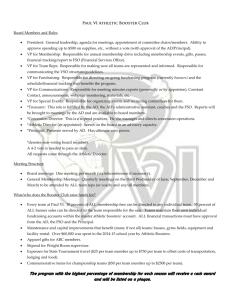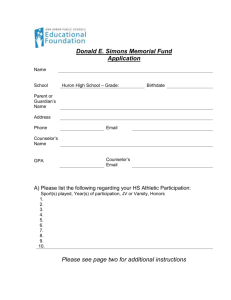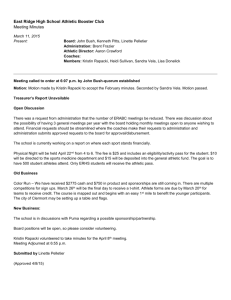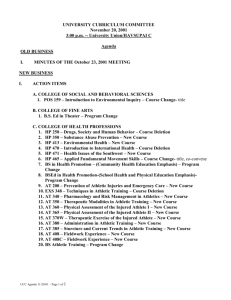Syllabus
advertisement
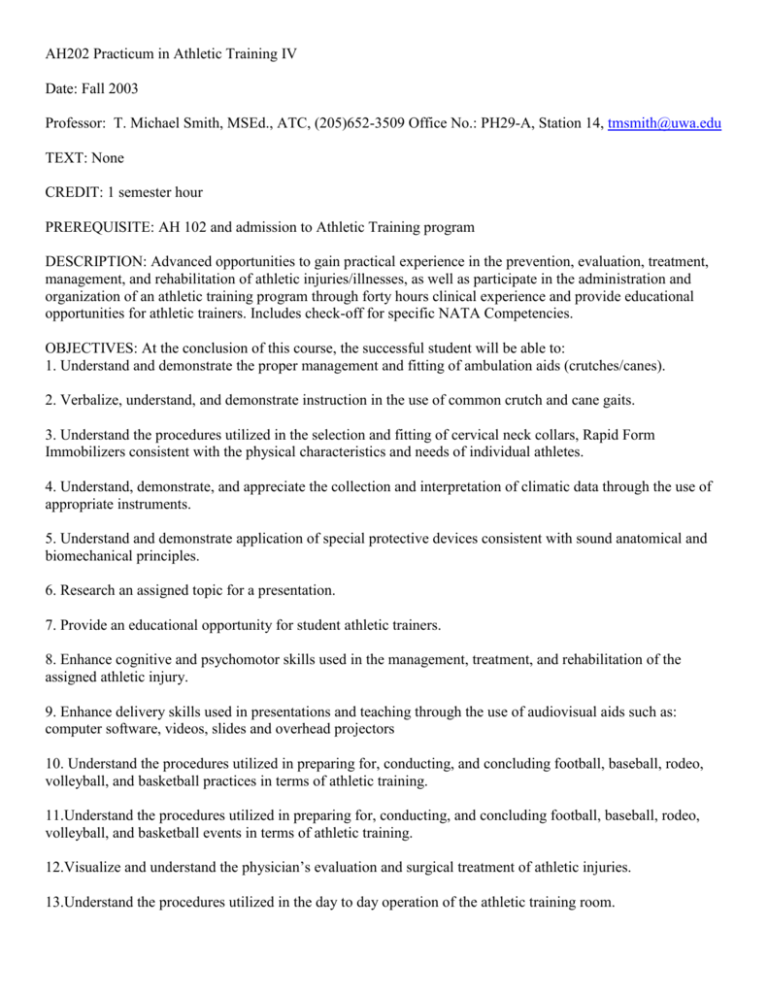
AH202 Practicum in Athletic Training IV Date: Fall 2003 Professor: T. Michael Smith, MSEd., ATC, (205)652-3509 Office No.: PH29-A, Station 14, tmsmith@uwa.edu TEXT: None CREDIT: 1 semester hour PREREQUISITE: AH 102 and admission to Athletic Training program DESCRIPTION: Advanced opportunities to gain practical experience in the prevention, evaluation, treatment, management, and rehabilitation of athletic injuries/illnesses, as well as participate in the administration and organization of an athletic training program through forty hours clinical experience and provide educational opportunities for athletic trainers. Includes check-off for specific NATA Competencies. OBJECTIVES: At the conclusion of this course, the successful student will be able to: 1. Understand and demonstrate the proper management and fitting of ambulation aids (crutches/canes). 2. Verbalize, understand, and demonstrate instruction in the use of common crutch and cane gaits. 3. Understand the procedures utilized in the selection and fitting of cervical neck collars, Rapid Form Immobilizers consistent with the physical characteristics and needs of individual athletes. 4. Understand, demonstrate, and appreciate the collection and interpretation of climatic data through the use of appropriate instruments. 5. Understand and demonstrate application of special protective devices consistent with sound anatomical and biomechanical principles. 6. Research an assigned topic for a presentation. 7. Provide an educational opportunity for student athletic trainers. 8. Enhance cognitive and psychomotor skills used in the management, treatment, and rehabilitation of the assigned athletic injury. 9. Enhance delivery skills used in presentations and teaching through the use of audiovisual aids such as: computer software, videos, slides and overhead projectors 10. Understand the procedures utilized in preparing for, conducting, and concluding football, baseball, rodeo, volleyball, and basketball practices in terms of athletic training. 11.Understand the procedures utilized in preparing for, conducting, and concluding football, baseball, rodeo, volleyball, and basketball events in terms of athletic training. 12.Visualize and understand the physician’s evaluation and surgical treatment of athletic injuries. 13.Understand the procedures utilized in the day to day operation of the athletic training room. CONTENT OUTLINE: A. Crutch and cane fitting and ambulatory instruction. B. Application of cervical neck collors, Rapid Form Immobilizers. C. Use of sling psychrometer, Wet Bulb Globe Temperature Index, temperature, and humidity readings. Reading of wet bulb, reading of dry bulb, reading temperature and humidity index D. Basic protective device application of finger and wrist splints for various pathologies. E.Research a assigned topic for a presentation. F.Provide an educational opportunity for student athletic trainers. G. Enhance delivery skills used in presentations and teaching through the use of audiovisual aids such as: computer software, videos, slides and overhead projectors. H. Observation of the procedures utilized in preparing for, conducting, and concluding football, baseball, rodeo, volleyball, and basketball intercollegiate practices in terms of athletic training. I. Observation of the procedures utilized in preparing for, conducting, and concluding football, rodeo, volleyball, and basketball intercollegiate events in terms of athletic training. J. Observation of the procedures utilized in the day to day operation of the athletic training room. COURSE REQUIREMENTS: A. Web searches for various sports medicine sites. B. Sixty hours observation experience. C. Prepare a written paper to be presented to athletic training students D. Research and prepare a presentation on an assigned athletic training related topic. E. Use the Power Point computer software to assist with your presentation. F. Check-off and demonstration of assigned NATA competencies. G. Observation and written report of physician clinic and surgery at HealthSouth Medical Center EVALUATION: A. Web activities. 50pts. 13% B. Acquisition of clinical observation hours 60pts. 16% C. Written presentation 50pts. 13% D. Oral presentation 50pts. 13% E. Usage of computer software 50pts. 13% F. NATA competency check-offs 72pts. 19% G. Physician Observation 50pts. 13% POLICIES A. Attendance: A student cannot receive credit for a course if he/she does not attend at least two-thirds of the class meetings, regardless of the reason for the absence. B. Academic Misconduct: The academic misconduct policy of the UWA will be followed in this course. C. Request for Accommodation: All request for accommodation, for this course or any school event, are welcome, from students and parents. D. Discussion of Grades with Professor: Any student who receives failing grades during this course is urged to discuss this with the professor. COMPETENCIES NECESSARY TO PASS (STATE RULES) These competencies will be covered in whole or in part as determined by the material. 6.PreventionPsychomotorCollection and interpretation of climatic data (temperature, humidity) through the use of appropriate instruments (sling psychrometer, WGBT Index, etc.). 7.PreventionPsychomotorSelection and fitting of standard protective equipment and clothing consistent with the physical characteristics and needs of individual athletes and the demands of participation in specific sports activities. 8.PreventionPsychomotorSelection, fabrication, and application of appropriate preventive taping and wrappings, splints, braces, and other special protective devices consistent with sound anatomical and biomechanical principles. 8.RehabilitationCognitiveContemporary immobilization devices (casting materials, splints, etc.) and special protective equipment (braces, special pads, modified taping procedures, etc.) 8.RehabilitationCognitiveContemporary ambulation aids and ambulation techniques (crutch gaits, cane gaits, special ambulation techniques). 6.RehabilitationPsychomotorMeasurement and fitting of ambulation aids and instruction in the use of common crutch/cane gaits. 16.Education & Counseling Cognitive Availability of educational materials and programs in health related subject matter areas (AV aids, pamphlets, newsletters, workshops, seminars, etc.) 29.Education & Counseling Cognitive Basic principles of learning and motivation and methods of classroom instruction including instructional techniques, use of audiovisual aids, test construction, and evaluation of student competencies (including tasks within the six domains of the NATA Role Delineation Study). 30.Education & Counseling Cognitive Principles of organizing laboratory/clinical experiences and techniques of instruction in training room skills. 32.Education & Counseling Cognitive Principles of planning and organizing workshops, seminars, and clinics in athletic training and sports medicine for athletic health care personnel, administrators, coaches, and the general public. 6.Education & Counseling Affective Acceptance of the responsibility to interpret and promote athletic training as a professional discipline among allied professional groups and the general public. 7.Education & Counseling Affective Acceptance of the professional responsibility to remain abreast of current theory and practice athletic training and sports medicine. 8.Education & Counseling Affective Acceptance of the responsibility to enhance the professional growth of athletic training students, colleagues, and peers through a continual sharing of knowledges and skills. 9.Education & Counseling Affective Acceptance of the professional responsibility to create learning experiences which will provide athletic training students with an opportunity to develop the competencies necessary for effective functioning as a Certified Athletic Trainer. CALENDAR: Assessment Day- Students do not attend class. October 21, 2003 September 2 & 4 Selection and Assignment of Topic & Presentation Strategies September 9 & 11 Crutch and cane fitting and ambulatory instruction. September 16 & 18 Application of cervical neck collars, Rapid Form Immobilizers September 23 & 25 Use of sling psychometer, Wet Bulb Globe Temperature Index, temperature, and humidity readings. -Reading of wet bulb, reading of dry bulb, reading temperature and humidity index September 30 & October 2 Basic protective device application of finger & wrist splints for various pathologies. October 7 & 9 Introduction to Power Point, Topic Final Decision Due October 14 & 16 Techniques of Power Point, check-offs due October 21 & 23 Techniques of Power Point October 28 & 30 Techniques of Power Point November 4 & 6 Techniques of Power Point, Written Presentation Due November 11 & 13 Presentations begin November 18 & 20 Presentations December 2 & 4 Presentations & Hours and Injury Summaries due



